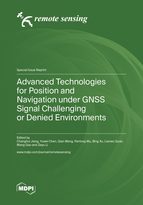Advanced Technologies for Position and Navigation under GNSS Signal Challenging or Denied Environments
A special issue of Remote Sensing (ISSN 2072-4292). This special issue belongs to the section "Engineering Remote Sensing".
Deadline for manuscript submissions: closed (31 July 2022) | Viewed by 75493
Special Issue Editors
Interests: hyperspectral LiDAR; GNSS; INS; Kalman filter; mobile mapping
Special Issues, Collections and Topics in MDPI journals
Interests: positioning and navigation technologies; multi-sensor fusion; LiDAR scanning
Special Issues, Collections and Topics in MDPI journals
Interests: GNSS; navigation integrity; resilient PNT; multi-sensor information fusion
Special Issues, Collections and Topics in MDPI journals
Interests: data fusion; target tracking; nonlinear filtering; integrated navigation
Special Issues, Collections and Topics in MDPI journals
Interests: signal processing; satellite positioning and navigation; GNSS receiver design; parameter estimation
Special Issues, Collections and Topics in MDPI journals
Interests: intelligent navigation; integrated navigation; cross-media navigation
Special Issues, Collections and Topics in MDPI journals
Interests: satellite geodesy; GNSS precise positioning; integrated navigation; multisensor fusion navigation; parameter estimation
Special Issues, Collections and Topics in MDPI journals
Interests: simultaneous localization and mapping; quality control
Special Issues, Collections and Topics in MDPI journals
Special Issue Information
Dear Colleagues,
Currently, with the popularity of smart devices, assured Position Navigation and Time (PNT) is critical for these devices and some fundamental infrastructures, i.e., power grid. The Global Navigation Satellite System (GNSS) is dominant in providing the PNT information due to its coverage and high accuracy. However, its signals are weak and it is vulnerable; multipath and None-Line-Of-Signals (NLOS) are the major errors that occur with regard to the GNSS in applications in urban areas. Advance signal processing methods are expected to improve its resilience and assurance. In addition, the GNSS is fragile to interference and spoofing, which should be emphasized for unmanned systems and smart devices.
Apart from improving the GNSS resilience in signal-challenging environments, the PNT without GNSS is critical for many applications—i.e., indoors, tunnels, underground, etc. Advanced technologies on high-accuracy inertial sensors and timing devices—i.e., MEMS Gyroscope, atomic interferometer gyroscope, nuclear magnetic resonance gyroscope, chip scale atomic clock, etc.—are the key to supporting PNT in GNSS-denied environments. Multisensor integration is also a prospective solution. This Special Issue aims to provide a platform for researchers to publish innovative work on the advanced technologies for position and navigation under GNSS signal-challenging or denied environments. Specifically, we invite contributions concerning the following topics:
- GNSS multipath and NLOS identification, mitigation or correction;
- Weak GNSS signal tracking and position determination;
- GNSS interference and spoofing detection;
- LiDAR/Visual SLAM;
- MEMS inertial measurement unit;
- Atomic Interferometer Gyroscope and Accelerometer;
- Indoor position;
- Multi-sensor integration and fusion;
- Micro-Technology for Positioning, Navigation, and Timing.
Dr. Changhui Jiang
Dr. Yuwei Chen
Dr. Qian Meng
Dr. Panlong Wu
Dr. Bing Xu
Dr. Lianwu Guan
Dr. Wang Gao
Dr. Zeyu Li
Guest Editors
Manuscript Submission Information
Manuscripts should be submitted online at www.mdpi.com by registering and logging in to this website. Once you are registered, click here to go to the submission form. Manuscripts can be submitted until the deadline. All submissions that pass pre-check are peer-reviewed. Accepted papers will be published continuously in the journal (as soon as accepted) and will be listed together on the special issue website. Research articles, review articles as well as short communications are invited. For planned papers, a title and short abstract (about 100 words) can be sent to the Editorial Office for announcement on this website.
Submitted manuscripts should not have been published previously, nor be under consideration for publication elsewhere (except conference proceedings papers). All manuscripts are thoroughly refereed through a single-blind peer-review process. A guide for authors and other relevant information for submission of manuscripts is available on the Instructions for Authors page. Remote Sensing is an international peer-reviewed open access semimonthly journal published by MDPI.
Please visit the Instructions for Authors page before submitting a manuscript. The Article Processing Charge (APC) for publication in this open access journal is 2700 CHF (Swiss Francs). Submitted papers should be well formatted and use good English. Authors may use MDPI's English editing service prior to publication or during author revisions.
Keywords
- micro-technology PNT
- micro-inertial sensors
- GNSS
- NLOS
- multipath
- signal processing
- multi-sensor integration
- LiDAR SLAM
- visual SLAM
- cooperative navigation
- pedestrian dead reckoning
- inertial navigation system
- smartphone
- autonomous driving
- indoor position
- RAIM (Receiver Autonomous Integrity Monitoring)
- chip scale atomic clock










